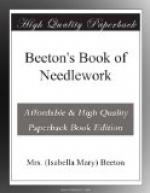[Illustration: 561.—Border in Guipure d’Art.]
Draw always the second stitch of 2 stitches through the first, and work 1 stitch in the stitch which has been drawn through the first, and then 1 stitch through the other stitch. In the 8th round work always 2 stitches in the stitch between the 2 crossed stitches, 1 stitch in all the other stitches. Lastly, darn the rosette, from illustration, with fine glazed cotton.
For the ground of the rosettes, illustrations Nos. 562 and 563, cast on 6 stitches, join the stitches into a circle, and work then in the 1st round 2 stitches in every stitch; in the following 8 rounds 2 stitches in every increased stitch, in all the other stitches 1 stitch. The last (10th) round is worked without increasing. Then darn the rosettes, from illustrations, with thread in darning stitch, linen stitch, and point d’esprit. The edges of the two rosettes are worked round in button-hole stitch; in every selvedge stitch work 3 button-hole stitches. These two rosettes can be joined together for small couvrettes.
[Illustration: 562.—Rosette in Guipure d’Art.]
[Illustration: 563.—Rosette in Guipure d’Art.]
The ground of the border, No. 561, is formed by a strip of straight netting 9 squares wide, cut out in vandykes on one side, and worked round in button-hole stitch, as seen in illustration. This ground is darned, from No. 561, in darning stitch, point d’esprit, linen stitch, and ornamented with bars and wheels (See illustration).
* * * * *
[Illustration: 564.—Corner Border in Guipure d’Art.]
564 and 565.—Corner Borders in Guipure d’Art.
Material: Messrs. Walter Evans and Co.’s Mecklenburg thread No. 20 for handkerchief, or No. 8 for couvrettes.
These corner borders are suitable for handkerchiefs, couvrettes, &c., or as strips of insertion for cushions or pillow-cases. They are worked with more or less fine cotton, according to the use they are meant for. They are edged round with button-hole stitch on the outside, and finished off with a row of crochet purl. Work 1 double in every button-hole stitch; after every other stitch draw out the loop on the needle about one-tenth of an inch; take out the needle and leave the loop as a purl; take up 1 loop in last double stitch, and cast it off with the next double stitch.
[Illustration: 565.—Corner Border in Guipure d’Art.]
* * * * *
566.—Jewel Case, forming Pincushion.
Materials: Deal box; satin ruche; satin ribbon; quilted satin and silk cord; guipure netting.
This case consists of a square cardboard or deal box, lined with satin, and slightly quilted; it is also covered on the top with satin, and ornamented all round with a satin ruche four-fifths of an inch wide, pleated in the manner seen in illustration. The top of the box is stuffed so as to form a pincushion. It is then covered with guipure d’art No. 567. Ornament all round with silk cords, and at the corners with bows of satin ribbon.




